As soon as September hits, all I want is my house to smell of cakes and warming spices. It’s understandable that when the days get shorter and the weather colder, we need that grounding, soothing yet festive quality in our lives.
I love having all these spices in my pantry, but isn’t it annoying when you have to take them all out to add to a recipe?
That’s why I decided to make my warming spice blend that I can use from September to March to make all the cakes and pies I want. Plus, this blend will also work well with savory dishes.
The inspiration
The inspiration for this warming spice blend came from a small spice box I bought in a tea and coffee shop in Romania. It was from a German brand called SimplyKeto, and it was made as a coffee spice blend to add to bulletproof coffee (Oriental Coffee Spice).
I loved it so much that I would open the box only to feel the smell. I added it to coffee, chicory drinks, cakes, pancakes, and crepes. I knew that if I could have a spice mix like this one in my pantry, I wouldn’t need to think about what spices to add each time I make a recipe requiring this flavor profile.
I studied the ingredient list and started to get all the spices I didn’t already have in my pantry.
What are the warming spices used in this mix?
I linked for you below each of the spices, with suggestions based on what I found available on Amazon US, but most of them I have not tried.
When it comes to spices, go with a trusted supplier, and buy organic and sustainable when possible. Whole spices will last longer.
- star anise
- Ceylon cinnamon (C5 grade)
- cloves
- licorice / liquorice
- green cardamom / true cardamom
- raw cacao nibs
- allspice berries
- long pepper / Indian long pepper / Thippalli
- tonka beans (Mill&Mortar, only in Europe)
A note about tonka beans
You will find an overview of these spices in the paragraphs below, but I’ll leave a quick note here about tonka beans.
While a prized ingredient among gastronomic enthusiasts and Michelin star chefs around the world, Tonka beans are not available on the US market, so if you don’t find them, don’t sweat it. This blend will be amazing even without them. But if you can buy them and feel their aroma, you’ll probably fall in love, as I did.
You will find more details about tonka beans at the end of this article.
LATER EDIT: In the meantime, a few options have appeared on Amazon US, so it seems like they can be purchased in the US.
Why use whole spices?
Ground spices start to lose their potency and quality when ground, so it’s better you buy them whole and grind them when you make the mix. Plus, when already ground, you will never know what the quality of spices that went into the mix was.
The only exception I made here was cinnamon, as the highest quality cinnamon I could get was ground. But I only buy small quantities from the best brands, so I have the guarantee they won’t be too old before I finish them.
However, if you can’t find one of the spices in the whole form, you can use powder. Just make sure it’s fresh and the best quality you can get.

How to grind spices
Spices are easy to grind in a spice grinder, a coffee grinder, or a Nutribullet with a milling blade.
I haven’t tried a powerful blender such as Vitamix, but I’m sure it works.
How to use this warming spice blend
You can use this spice blend for a number of dishes, both sweet and savory.
In sweet recipes, you can add it to chocolate or banana cakes, sweet potato pies, apple pies, gingerbread spiced desserts, muffins, biscuits, and anywhere pumpkin pie spice is required.
It goes well with porridges and is used as a main ingredient in our sorghum porridge recipe.
In drinks, you can add it to coffee, lattes, chicory drinks, chai lattes, chai tea.
In savory dishes, you can add it to meats, chicken, curries, and creamy soups.
Most of the recipes in my Holiday Recipe Guide can benefit from adding this spice blend. Sometimes I add extra ginger and turmeric powder.
For my Gluten-Free, Lectin-Free, and Sugar-Free Chocolate Banana Bread, I added 1 1/2 teaspoon of warming blend.
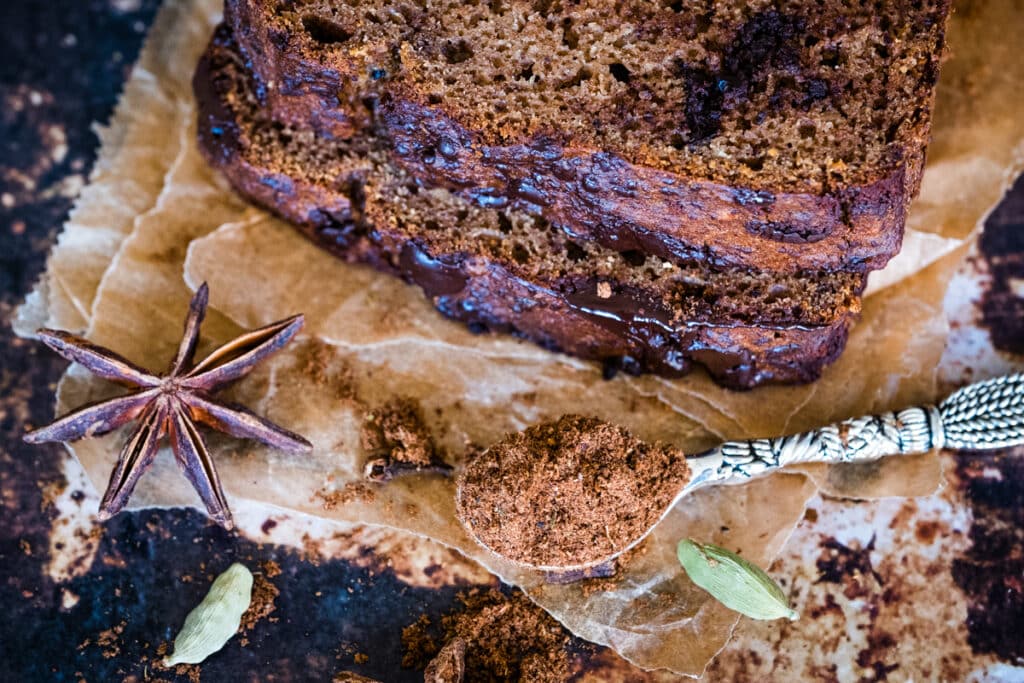
How much is a serving
These spices are very potent, and less is more. You can experiment to find the sweet spot for your taste, but I usually add one or a maximum of 2 teaspoons for a full-size cake or bread.
A note on the health benefits of these spices
All these spices have been used as natural remedies for different ailments for thousands of years in different cultures, and I had fun researching and discovering some of the ways they have been used.
More research is needed to prove most of those benefits, so don’t take this information as health advice. Please do your own research and talk to your doctor before trying to use any of these spices for medicinal purposes.
The only purpose of this article and recipe is to bring holiday flavors and aromas into your kitchen and home, and help you cook delicious food for yourself and your loved ones.
However, we know that most of these spices are full of polyphenols. In his book Unlocking the Keto Code, Dr. Steven Gundry lists cloves, cinnamon, and allspice as the top three polyphenol-rich herbs and spices. They are potent mitochondrial uncouplers, as well as mitogenesis promoters.
What does mitochondrial uncoupling do for you?
According to Steven Gundry, MD:
- Uncoupling “wastes calories” by allowing particles to leave mitochondria instead of making fuel.
- This protects mitochondrial health, as mitochondria with too many particles and too many ROSs’ (Reactive Oxygen Species) can be damaging.
- It also produces heat through a process called thermogenesis.
- Thermogenesis supports weight loss, vitality, and optimal health.
Star Anise
Mild and fragrant licorice flavor
Star anise is a spice that closely resembles licorice and anise in flavor, which makes it great to use in both sweet and savory dishes.
Native to northeast Vietnam and southwest China, star anise is one of the five ingredients in the traditional ‘five spice’ blend mix, alongside Sichuan pepper, cinnamon, cloves and fennel, although some recipes can include other spices such as ginger and cardamom.
Star anise is also a major ingredient in Indian cuisine and is used in making pho, the Vietnamese noodle soup.
The only way I used star anise so far in my cooking was as an ingredient in my Chinese five-spice blend, which I used to flavor meat dishes prepared in the pressure cooker. And once, guided by a Vietnamese friend, I made pho using whole star anise.
Health benefits of star anise:
- Rich in bioactive compounds that have powerful antioxidant, anti-inflammatory, and antimicrobial and anti-viral properties: Linalool, Quercetin, Anethole, Shikimic acid, Gallic acid, Limonene

Cinnamon
Sweet and woody, with a warm, earthy flavor
Cinnamon, which comes from the bark of the evergreen tree Cinnamomum Verum (Ceylon Cinnamon tree), is one of the most commonly used warming spices worldwide, but not all cinnamon you find in stores is created equal.
Ceylon, native to Sri Lanka and Southern parts of India, is called the “true cinnamon” and is considered the best quality and tastiest cinnamon. Most of the cinnamon sold in supermarkets and used in processed foods is, in fact, an inferior type of cinnamon called Cassia.
True cinnamon has a sweet, warm taste and a delicate wafting aroma. All real cinnamon is hand-cut as opposed to Cassia cinnamon, which can be processed mechanically.
Another quality rating system of cinnamon is organized by the diameter of the quills. ALBA cinnamon is considered the highest grade (6mm-7mm) and is the most expensive, followed by C5 Special, C5, also considered very high quality and organic. The quality will decrease from here.
For this warming spice blend, I used true cinnamon, C5 grade, from Mill&Mortar (only available in Denmark, the UK and a few other European countries).
A similar quality found on Amazon US is:
While most of the other spices I used in this blend were in their whole form, I prefer to use cinnamon that is already powdered.
Health benefits of cinnamon:
- Cinnamon comes second, after cloves, on the top ten polyphenol-rich herbs and spices
- Due to its high content of antioxidants and polyphenols, cinnamon has anti-inflammatory properties and can help with blood sugar levels and reduce bad cholesterol.
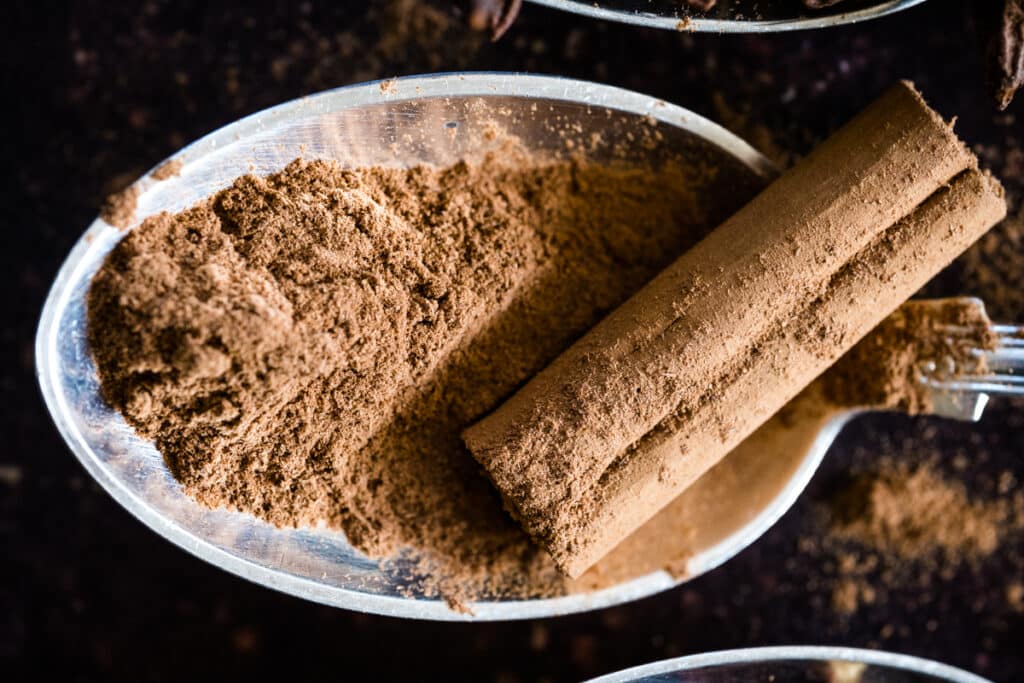
Cloves
Sweet, bitter, and astringent
Cloves are the aromatic flower buds of a tall tree called Syzygium aromaticum, growing in Indonesia and Sri Lanka. The harvest takes several days as the buds must be picked at the right time. Fresh and good-quality cloves can be distinguished by their porous light brown buttons that join the dark stalk.
Cloves are an essential ingredient in the delicious Chinese ‘five-spice’ blend and many other curry mixtures. In Danish cuisine, cloves are a must in pork roast with red cabbage pickles, chutneys, and other fruit preserves. It can also be used in spice cakes and honey cakes. Cloves can easily be ground with a mortar and pestle or in a coffee grinder.
With its pungent, intense flavor and aroma, cloves are one of the star spices in many warming spice blends, especially those used around holidays: gingerbread, pumpkin pie spice,
Health benefits of cloves:
- Top the list of polyphenol-rich herbs and spices, and it’s a powerful mitochondrial uncoupler.
- Are full of antioxidants.
- Contain fiber and are especially rich in manganese, which is an important nutrient for bone health.
- Contain eugenol, which some research suggests protects against cancer.
- Cloves have anti-microbial properties; they promote oral and gut health.
- Research suggests they can protect the liver and the digestive system and keep blood sugar stable.
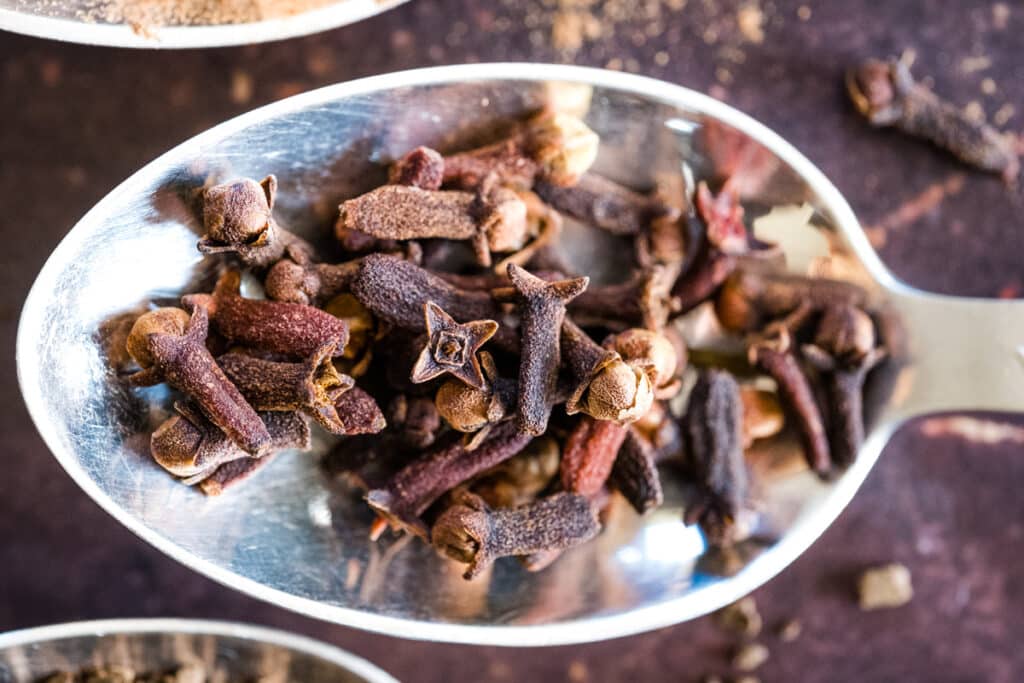
Licorice / Liquorice
Sweet, elegant, herbal taste and notes of anise and fennel
Licorice is the sweet, aromatic flavor extracted from the roots of Glycyrrhiza glabra, an herbaceous perennial legume native to Western Asia, Noth Africa, and Southern Europe.
Licorice complements any warming spice mix, and it works well in both savory and sweet dishes. Due to its anise-like flavor, I love to pair licorice with shrimps, garlic, coconut milk, parsley, and lemon. It can also add natural sweetness to sugar-free desserts and drinks.
As a spice, it can be found as wood sticks or powder. Do not use any form of processed licorice, such as soft licorice sticks (black or in other colors), or candy, as those are processed and sweetened.
For this warming spice blend, I used licorice powder from Calabria, Italy.
Health benefits of licorice:
- Is considered one of the world’s older herbal remedies. Today, many people utilize licorice root to treat heartburn, acid reflux, hot flashes, coughs, and bacterial and viral infections
- Licorice root may have potent antioxidant, anti-inflammatory, and antimicrobial effects
- Licorice root may increase blood pressure if used in big quantities; that’s why some people who suffer from low blood pressure use licorice as a remedy. If you have HBP, don’t overconsume licorice.
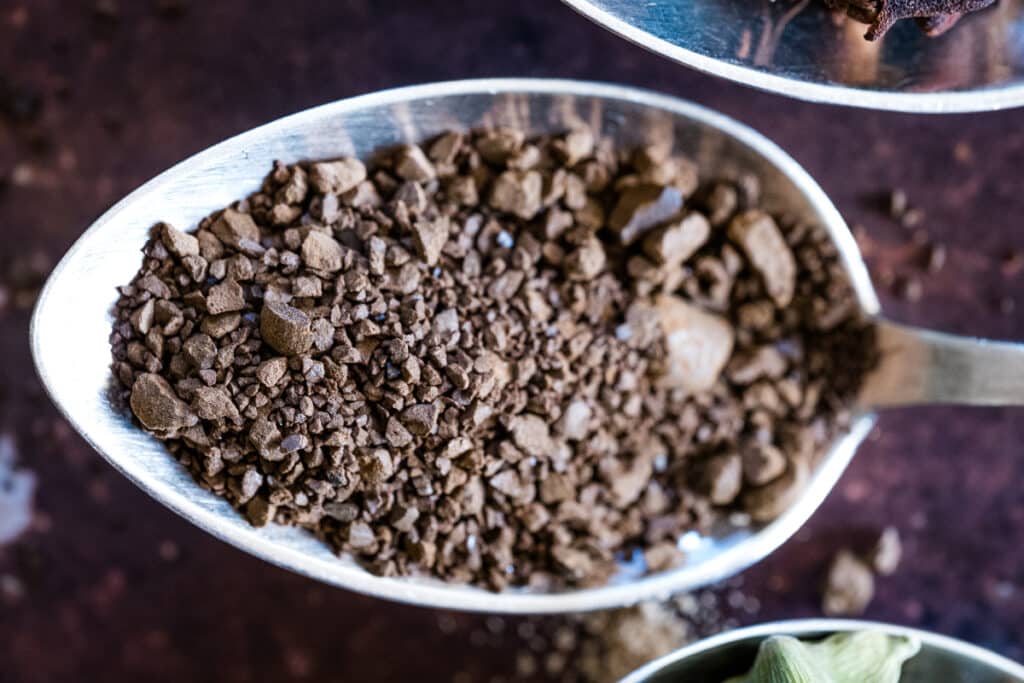
Cardamom
Herbal warmth, sweet, citrusy, a fragrant cross between eucalyptus, mint, and pepper
Did you know cardamom is called the Queen of Spices? That is not only because it has such an exquisite flavor, but it’s the most widely used spice after pepper and quite challenging to harvest. Cardamom is the second most expensive spice, by weight, after saffron.
Cardamom is a fruit of several species of plants in the ginger family, but Elettaria cardamom, also called small cardamom, true cardamom, or green cardamom, is considered superior quality. It is native to the moist forest of southern India.
The quality of the whole cardamom can be assessed by its bright, light green color, indicating whether the pod has been harvested at the right time and if it is tenderly dried in small ovens. The cardamom pods contain small seeds that should ideally be dark gray or black. White seeds and a washed green color indicate that the cardamom is too old or not processed correctly.
This is one of the reasons it is better to buy whole cardamom from a trusted spices supplier and grind it at home.
I love to use cardamom in coffee, bread, pastry, stir-fry, and Indian dishes.
Health benefits of cardamom
- An ancient remedy that may have many medicinal properties.
- Cardamom has anti-inflammatory, anti-bacterial and anti-viral properties.
- It’s used to improve oral health.
- May improve breathing and digestive health.
- Although more research is needed, certain compounds in cardamom may increase the capacity of natural killer cells to attack tumors.

Cacao
Bitter, crunchy, rich
Not exactly known as a spice, cacao has been used for centuries as a savory spice, adding depth of flavor to meats and vegetables.
For this mix, I used raw, unsweetened cacao nibs to add the depth and richness reminiscent of chocolate. Cacao nibs are dried and fermented cacao seeds that have been chopped into small pieces. They are bitter and have a crunchy texture, like roasted coffee beans.
I love the crunchy factor of cacao nibs and add them to cakes, smoothies, and porridge.
Health benefits of cacao
- Cacao is considered a superfood and, if it’s not mixed with sugar and dairy, is a powerhouse of nutrition.
- Cacao is full of antioxidants, fiber and is a great source of magnesium.
- The flavanols in cacao provide a boost to brain health.
- Flavanols in cacao are associated with a lower risk of heart disease.
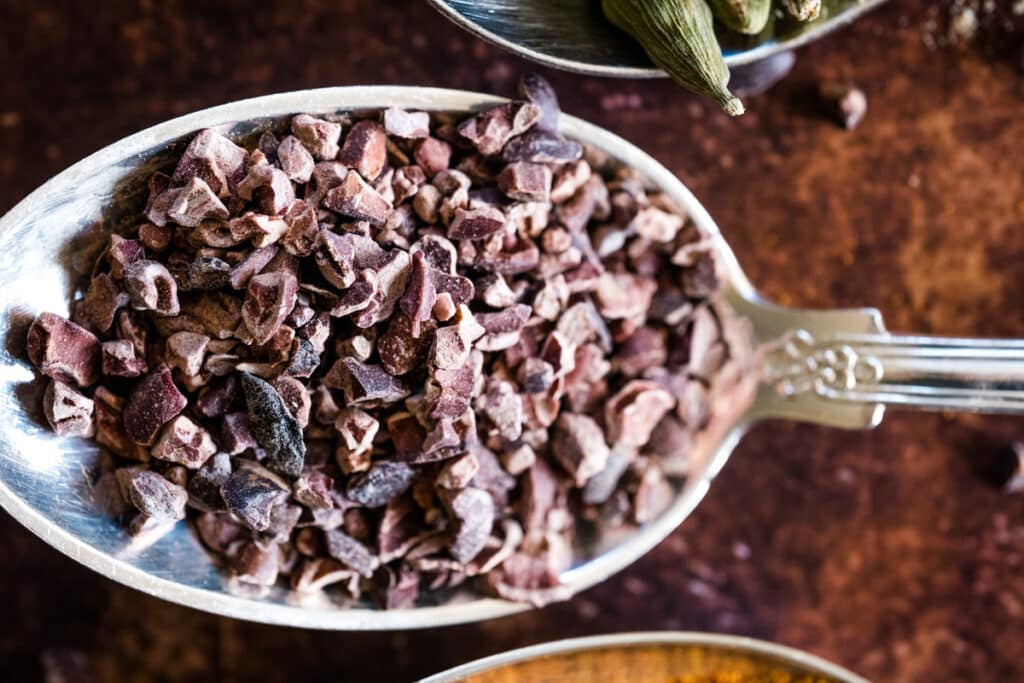
Long Pepper (Thippali, or Indian long pepper)
Long pepper has a slight musk aroma but also sweet notes of nutmeg, cinnamon, cardamom, and ginger
This profile makes the spice extremely interesting to work with for both salty and sweet dishes.
Although much bigger than black pepper, long pepper grinds easily, so I used the whole spice in this mix. I love the subtle and flavorful heat that long pepper adds to this warming spice blend.
Historically, long pepper has been used the same way as black pepper. Try it in marinades, in stews and pickling, or soups, just as you would use black pepper. Long pepper can be used whole, but can also be ground.
In South Asian cuisine, long pepper is used to flavor lentil dishes and pickles. Long pepper will pair well with earthy ingredients such as artichokes, mushrooms, and asparagus. The burnt tones make long pepper popular in the fantastic Asian BBQ kitchen for marinades or rubs, often with spicy flavors. Long pepper is also used in tea with honey.
Health benefits of long pepper
- While there are not many studies to prove its benefits, long pepper has been traditionally used for menstrual problems, erectile dysfunction, and bacterial infections.
- It can help relieve chronic headaches and toothache.

Allspice
A berry like a blend of flavors and aromas: cloves, nutmeg, star anise, fennel, black pepper, cinnamon
Allspice is one of my favorite spices, which I often use in my cooking. When I had to go on a low-histamine diet a while ago, I discovered that while most warming spices are considered high-histamine, allspice is not.
I used allspice in my Parsnip Cake With Rosemary and Olive Oil, in the Sweet Potato Pie, and many other savory dishes like curries and stews, even to make tacos, to replace high-histamine cumin.
Allspice is made from the dried, aromatic berries of a plant known as Pimenta dioica, which is a member of the myrtle family.
Allspice it’s is a common ingredient in Danish and Romanian cuisine. In fact, my dad’s favorite spice mix, which he mixes in a grinder, is whole allspice berries, black pepper, and coriander seeds. In Denmark, allspice is used in meatballs, liver pâté, red cabbage pickles, soups, and sausages. In sweet dishes, allspice lends itself beautifully to biscuits, apple compote, apple tarts, and pies. It is often used with cinnamon and cloves.
It can be ground in a mortar and pestle, a coffee grinder, or even used whole.
Health benefits of allspice
- Due to chemical compounds such as eugenol, quercetin, and tannins, allspice may have antimicrobial, antibacterial, antiseptic, and anti-inflammatory properties.
- Allspice is third on the list of polyphenol-rich herbs and spices, after cloves and cinnamon.
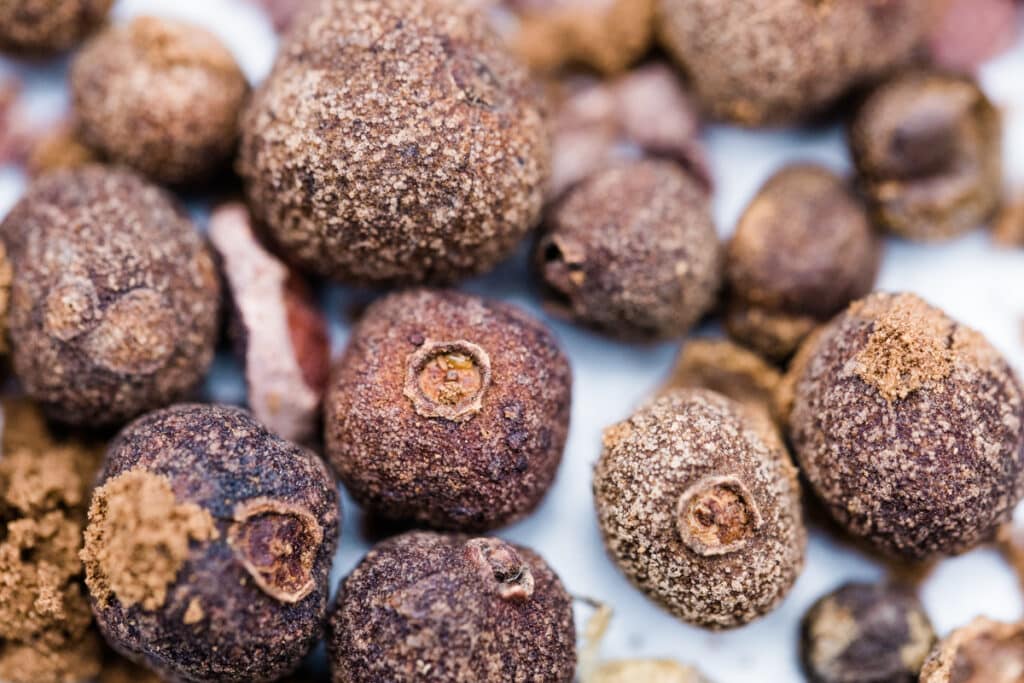
Tonka Beans, the forbidden spice
Notes of bitter almonds, vanilla, cinnamon, and cloves
I left this one at the end for a few reasons. Firstly, tonka beans are not available in the United States, where they have been banned since 1954, due to a compound found in tonka beans, called coumarin.
Coumarin has shown toxicity in extremely high concentrations. However, gastronomic enthusiasts are calling for the removal of this ban, as the level to which coumarin in tonka beans would become toxic is unlikely to be ingested.
Since the ban, coumarin was also discovered in lavender, licorice, strawberries, and cherries, and also in some types of cinnamon (which technically would make these foods illegal).
To ease your mind: to overdose on tonka beans, you will have to eat at least 30 whole beans (about 1g of coumarin). In this blend, which makes 50g of spice mix, you will find one or two beans.
The second reason I left tonka beans at the end of the list, is because they are a legume, and legumes contain lectins. However, the quantity of this spice will be so small in a blend that I don’t think the lectins would have any ill effect. We encounter the same situation in paprika and cayenne pepper. Both are dried and ground with the skins on, but they are still approved on a plant paradox diet.
In France, tonka beans are used in cuisine and perfume. To my surprise, I easily find them on shelves in supermarkets in Denmark, in the baking section.
You can read more about tonka beans here: The Tonka Bean: An Ingredient So Good It Has to Be Illegal
My last thought about tonka beans is that they are the most fantastic, aromatic, flavorful spice I’ve ever tried. The first note that hits me is bitter almonds (amaretto), which I love, then vanilla, cinnamon, and cloves. It’s strong but subtle at the same time. No wonder is such a prized ingredient among gastronomic enthusiasts and Michelin star chefs.
If you are in the US, like most of my readers, this warming spice blend will be amazing without the tonka beans, so please don’t sweat if you can’t find it. If you are in Europe or other countries where you can find them, add or skip them, depending on how you feel about coumarin.
In sweet dishes, tonka bean flavor can be replaced with pure almond extract and vanilla. In savory dishes, the mix will work perfectly without adding the beans.

I hope this warming spice blend will make your house smell like a holiday and bring a grounding and soothing energy to your life. Please let me know if you make it and how you use it.
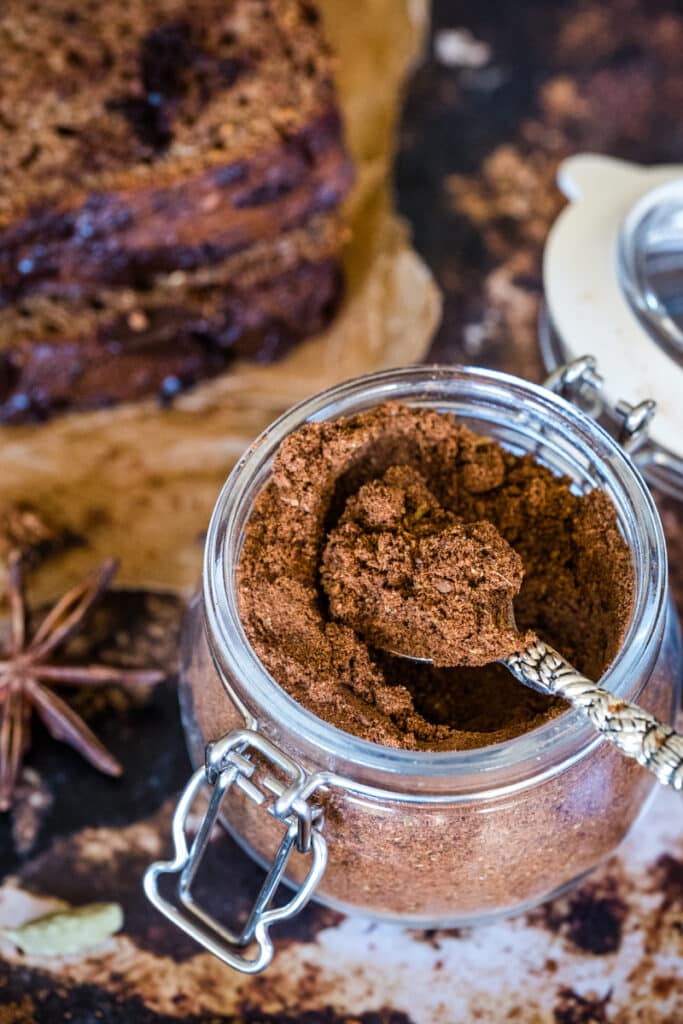
*This post contains affiliated links, which means I get a small commission if you choose to purchase something via one of my links, at no extra cost to you.
Print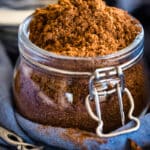
Holiday Warming Spice Blend
- Prep Time: 5 minutes
- Total Time: 5 minutes
- Yield: 50 grams of blend
Description
As soon as September hits, all I want is my house to smell of cakes and warming spices. It’s understandable that when the days get shorter and the weather colder, we need that grounding, soothing quality in our lives. I love having all these spices in my pantry, but isn’t it annoying when you have to take them all out to add to a recipe? That’s why I decided to make my warming spice blend that I can use from September to March to make all the cakes and pies I want. Plus, this blend will also work well with savory dishes.
Ingredients
- 9 grams star anise, whole
- 9 grams Ceylon cinnamon, ground
- 8 grams cloves, whole
- 5 grams licorice powder
- 5 grams cardamom, whole
- 5 grams raw cacao nibs
- 5 grams allspice, whole
- 3 grams long pepper (Thippali), whole
- Optional: 1, 2 grams Tonka beans, whole (for those in the US, where Tonka can’t be found, the taste profile can be replaced with a mix of vanilla and nutmeg).
Instructions
- Add all the whole ingredients to a spice mill or a Nutribullet with a milling blade. Blend all until finely ground.
- Add the powder ingredients and pulse, and shake a few times until all gets mixed.
- Add the blend to a jar, close well, and store in a dark and cool place for a few months.
- If you don’t have access to Tonka beans, don’t worry, the blend will be amazing anyway. You can replace the flavor profile with vanilla or a mix of vanilla and nutmeg. However, if you also want to use the mix for savory dishes, don’t add vanilla to the blend. You can add vanilla to taste when baking or making sweet dishes.
Notes
If you don’t find some of the spices in the whole form, you can add them as powders.
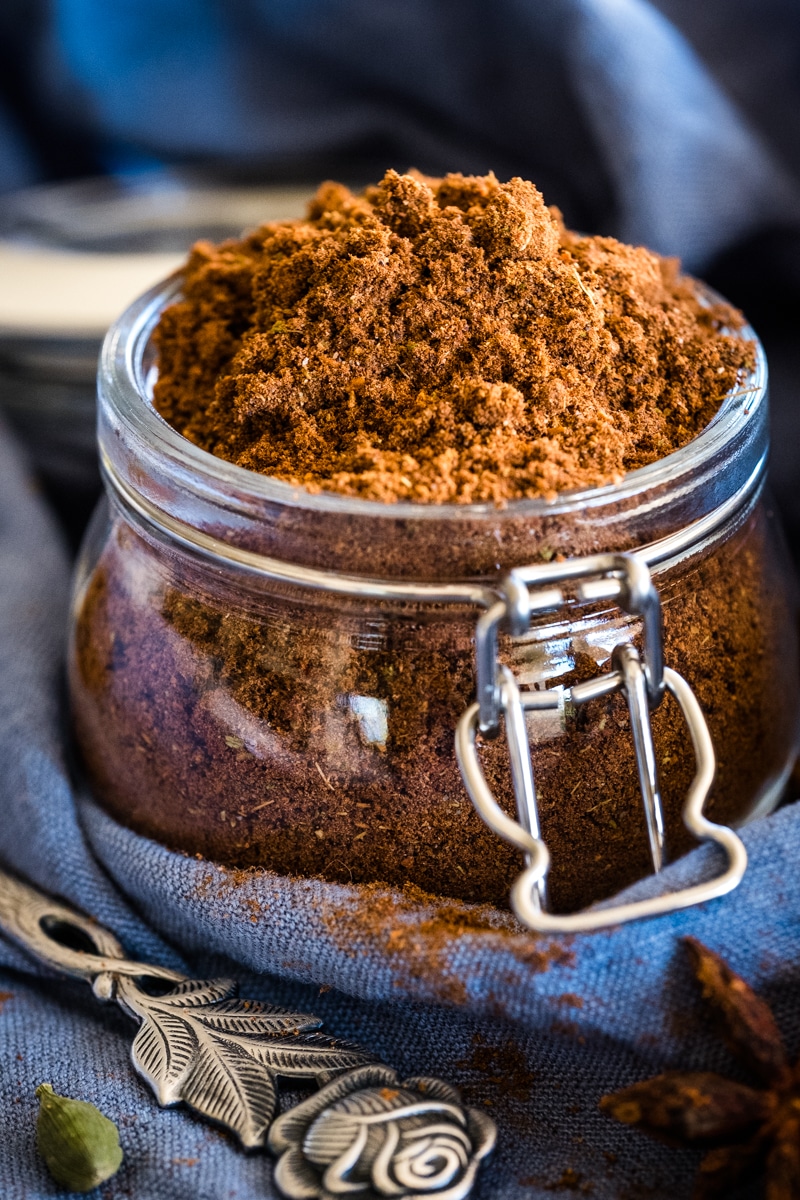

4 Comments
Sue O'Reilly-McRae
December 15, 2024 at 6:16 pmHi Claudia,
I have purchased the spices to make this mix. I’m struggling with the small measurements. I want to make enough to fill 12, 2 ounce glass jars. Can you tell me how much the recipe listed above makes in ounces?
Thanks,
Sue
Claudia
December 16, 2024 at 8:34 amHi Sue! 50 grams is about 1.8oz. So if you double this quantity, you will make 100 grams (about 3.6oz). I hope this helps. -Claudia
Sue O'Reilly-McRae
January 5, 2025 at 12:19 pmHi Claudia
I borrowed a friend’s scale and made a couple of batches to give as gifts. I gave small jars to 7 women in my town who take turns with me baking for coffee hour at our library on Saturday mornings. We sip coffee, nibble and talk about books and life. It’s great. One of my friends has joined me in the Gundry diet approach and she was excited about your website. I made a puffed millet granola with Yakon syrup and the spice mix. Delicious! Thanks for all you do.
Claudia
January 6, 2025 at 4:11 amHi Sue! Thank you so much for the kind words. Your Saturday mornings sound so cozy, you are lucky to have such a group of friends. Please send my love to everyone. -Claudia